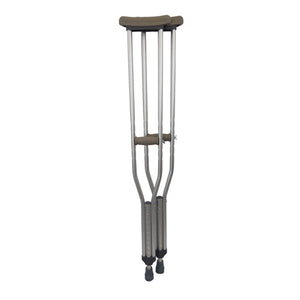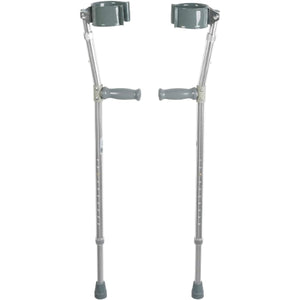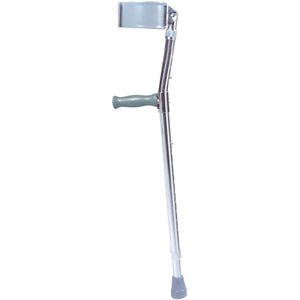Are you looking for the right mobility support to help a loved one move independently and confidently? Learning how to use a rollator walker correctly can dramatically improve mobility for seniors or individuals with walking limitations. A rollator walker isn't just a tool—it’s a reliable aid that promotes safety and freedom, both indoors and outdoors.
In this guide, we’ll walk you through the best rollator walker techniques, key safety practices, and usage tips. You can also explore the Rollator Walkers Collection online to find the most suitable model for your needs.
Using crutches comfortably and safely starts with getting the height just right. If your crutches aren’t adjusted correctly, it can lead to discomfort, poor posture, and even injury.
Whether you're recovering from surgery, injury, or using crutches long-term, this step-by-step crutch height guide will show you exactly how to adjust crutches to your height for optimal comfort and safety.
When Should You Use Crutches for Leg or Foot Support?
You may need crutches for walking support if you’ve injured your leg, foot, ankle, or had surgery that limits weight-bearing on one side. Crutches help redistribute your body weight to your arms, taking pressure off the injured limb to allow healing.
Crutches are also essential if you have mobility issues from bone, joint, or nerve conditions. Always follow medical advice before using crutches for mobility.
Step-by-Step Guide: How to Adjust Crutches to Fit Your Height
The following steps will walk you through the correct way to adjust underarm or forearm crutches for your body size.
1. Stand Upright for Accurate Crutch Adjustment
To begin, stand upright in shoes you typically wear. Your feet should be shoulder-width apart to ensure even weight distribution.
This natural posture gives you a solid starting point for fitting crutches correctly to your height.
2. Position Crutches for Initial Sizing
Place the crutches about 15 cm (6 inches) in front and slightly to the sides of your feet. Avoid positioning them directly under your armpits.
This angled placement helps you find the proper crutch position for stability and balance.
3. Locate and Loosen the Crutch Hand Grips
Find the adjustable hand grips located halfway down the crutch. Most crutches use push buttons or wing nuts to adjust the height.
Loosening the mechanism is the first step in setting the right handgrip height for crutches.
4. Measure from Wrist to Floor for Grip Height
Stand with your arms relaxed at your sides. Measure from the floor to your wrist crease. This is the optimal height for your crutch hand grips.
This method ensures handgrips align with natural arm movement, improving control while walking.
5. Adjust Crutch Hand Grips to Match Wrist Height
Adjust the crutch hand grips to the height you just measured. Be sure to adjust both crutches evenly for balance and stability.
Having symmetrical grip height ensures better support and reduced arm fatigue.
6. Secure Hand Grip Adjustment Firmly
Once the hand grips are aligned properly, tighten the wing nuts or push buttons to lock them in place.
A secure lock prevents slipping and maintains safe and reliable crutch height settings while walking.
7. Check Elbow Angle for Proper Crutch Fit
Hold onto the grips and check your elbow bend. A slight bend of 15–30 degrees at the elbow provides the ideal angle for support and mobility.
This elbow position is a key part of correct crutch fitting techniques for daily use.
8. Test-Walk with Crutches and Make Final Adjustments
Take a few careful steps using your adjusted crutches. Walk slowly and observe how your weight distributes through the crutches and legs.
If you feel off-balance or strain, recheck the crutch height and hand grip settings. Adjust as needed for optimal comfort.
Frequently Asked Questions About Crutch Adjustment and Use
1. What is the correct height for crutches?
The top of the crutch should be 1 to 1.5 inches below your armpit when you’re standing upright. The handgrips should line up with the crease of your wrist, allowing a 15–30° elbow bend when holding them.
2. How do you adjust hospital crutches for a patient?
Loosen the adjustment mechanism (push buttons or wing nuts), then raise or lower the crutch's lower section. Once it’s the correct crutch height, secure the mechanism and repeat for the second crutch.
3. How do you walk properly with crutches?
Place both crutches a foot ahead, then move your injured leg and crutches forward together. Use your arms to support your body as you bring your uninjured leg forward.
4. Should the crutches touch your armpits while walking?
No. Crutches should not touch your armpits. Constant contact can cause nerve compression. Keep about 1–1.5 inches of space between the crutch top and your underarm.
Q5. Can you adjust crutches without tools?
Yes. Most modern crutches come with tool-free push-button adjustments or easy-to-tighten wing nuts for quick setup.
Need the Right Crutches? Shop Crutches Online at MoovKart!
Looking for well-fitted crutches delivered to your doorstep? MoovKart offers a wide variety of adjustable crutches designed for comfort, durability, and support.
Whether you need forearm crutches, underarm crutches, or lightweight walking aids, you’ll find the perfect match online at MoovKart.
Shop now and enjoy fast shipping, reliable support tools, and pain-free walking solutions!
A Rollator Walker and Its Uses
A rollator walker, also known as a rolling walker, is a four-wheeled mobility aid designed to assist people who face difficulty walking due to aging, injury, or disability.
Equipped with ergonomic handles, a sturdy frame, brakes, and often a padded seat, this device helps maintain balance while reducing the strain on joints. Rollators are especially ideal for those seeking proper rollator walker use indoors as well as smooth rollator walker outdoor navigation.
Unlike standard walkers, which need lifting to move, rollators glide forward easily. This makes them perfect for everyday use, whether transitioning between rooms or navigating public pathways.
Rollator Safety Tips: Proper Usage Guidelines
To use a rollator walker safely, follow these expert-backed steps. These rollator walker safety tips for seniors ensure confident, injury-free mobility.
1. Read the Manufacturer’s Instructions Carefully
Start by reading the instruction manual that comes with your device. Each rollator model has specific settings, and understanding these ensures safe use. Watching setup videos can also help you familiarize yourself with how to use a rollator walker correctly from day one.
2. Maintain the Correct Hand Position
One of the best rollator walker techniques is learning how to hold the handles properly. Walk close to the rollator, gently wrapping your fingers around the handgrips with your thumbs near the brakes. This position allows for quick brake access in case of sudden imbalance.
3. Practice Safe Turning Techniques Indoors First
Turning corners requires caution. Begin by practicing turns in a spacious indoor area. Look ahead while navigating and avoid sharp pivots. This aligns with both proper rollator walker use indoors and outdoor navigation.
Keep in mind that turning with a rollator is similar to maneuvering a vehicle—it requires extra clearance.
4. Use and Adjust Brakes Correctly
One of the most crucial rollator walker safety tips for seniors is knowing when and how to use the brakes. Whether you’re going downhill, sitting on the built-in seat, or standing still, brakes are essential.
Make sure you learn the art of adjusting rollator walker brakes safely, especially when walking on slopes or uneven ground.
5. Balance Your Weight Without Leaning
Avoid placing your full body weight on the walker. Rollators are built for balance support, not for weight-bearing. Instead, maintain your natural walking stride and keep your torso centered. This habit supports balance and aligns with the best practices from the rollator walker walking posture guide.
6. Use a Flashlight for Nighttime Navigation
For evening walks, attach a flashlight to the frame. This small adjustment greatly improves visibility and helps others see you, supporting rollator walker outdoor navigation tips and enhancing safety after dark.
7. Take Small, Steady Steps When Turning
Turning quickly can cause loss of control. Always take small steps that match your walker’s movement. Allow the wheels to roll naturally and pivot gradually—especially useful when using a rollator walker on uneven ground.
8. Stay Aligned Within the Frame
Ensure your upper body is aligned inside the rollator frame while walking. Avoid extending your torso too far forward or walking behind it. This habit supports balance and aligns with the best practices from the rollator walker walking posture guide.
Do’s and Don’ts of a Rollator Walker
Using a rollator for the first time may feel awkward, especially for older adults. Follow these rolling walker etiquette in public tips and avoid common mistakes.
Do’s
- Walk upright with confidence
- Always look forward while moving
- Keep the rollator at a steady, manageable pace
- Take short and natural steps
- Allow ample turning space, especially in public or tight areas
Don’ts
- Do not lean all your weight on the walker
- Avoid walking too quickly
- Do not look down constantly while walking
- Refrain from dragging or shuffling your feet
FAQs
Q1. Who should not use a rollator walker?
A1. People with significant balance issues or who need heavy body weight support should consider other mobility options, as rollators are not designed for full weight-bearing.
Q2. At what optimum height should I push my rollator?
A2. The ideal handle height is at the level of your wrist bones when your arms hang naturally by your sides.
Q3. How do you set up a rollator walker?
A3. Begin by assembling the frame, adjusting the handlebars, attaching any accessories, and ensuring the brakes work properly. Always test it before first use to confirm correct assembly.
Q4. What is the difference between a walker and a rollator?
A4. A standard walker usually has two wheels or no wheels and must be lifted to move. A rollator, on the other hand, has four wheels, a seat, and hand brakes, making it ideal for people who need assistance but can still walk with balance.
Conclusion
Rollator walkers are highly effective tools that promote safer and more independent walking for seniors and mobility-challenged individuals. When you understand how to use a rollator walker correctly, your risk of falling decreases and your confidence improves.
Apply these rollator walker safety tips for seniors every time you use the device. Be careful while walking, turning, and sitting. If you're unsure, don't hesitate to reach out to a therapist for additional guidance.









